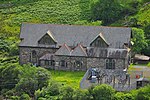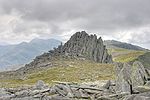Pen-y-Gwryd

Pen-y-Gwryd is a pass at the head of Nantygwryd and Nant Cynnyd rivers close to the foot of Snowdon in Gwynedd, Wales. The area is located at the junction of the A4086 from Capel Curig to Llanberis and Caernarfon and the A498 from Beddgelert and Nant Gwynant about a mile from the head of the Llanberis Pass. It is close to the boundary with Conwy county borough in northern Snowdonia. The famous mountaineering hostelry, Pen-y-Gwryd Hotel, is located in the pass. It is also a mountain rescue post with links to the other rescue posts at Ogwen Cottage and Plas y Brenin. The Old Miners' Track from the Snowdon copper mines are now part of the modern A4086 road between Pen-y-Gwryd and Pen-y-Pass. It continues northwards beyond Pen-y-Gwryd skirting Glyder Fach to Bwlch Tryfan and Dyffryn Ogwen. From Pen-y-Pass is the "PYG track", one of the many routes leading to the summit of Snowdon, its name is believed be derived from the initials ("P-y-G"). However, older maps show it as the "Pig track", a name derived from Bwlch y Moch (the Pigs' Gap).
Excerpt from the Wikipedia article Pen-y-Gwryd (License: CC BY-SA 3.0, Authors, Images).Pen-y-Gwryd
A4086,
Geographical coordinates (GPS) Address Website External links Nearby Places Show on map
Geographical coordinates (GPS)
| Latitude | Longitude |
|---|---|
| N 53.08256 ° | E -4.00203 ° |
Address
Pen-y-Gwryd Hotel
A4086
LL55 4NT
Wales, United Kingdom
Open on Google Maps










